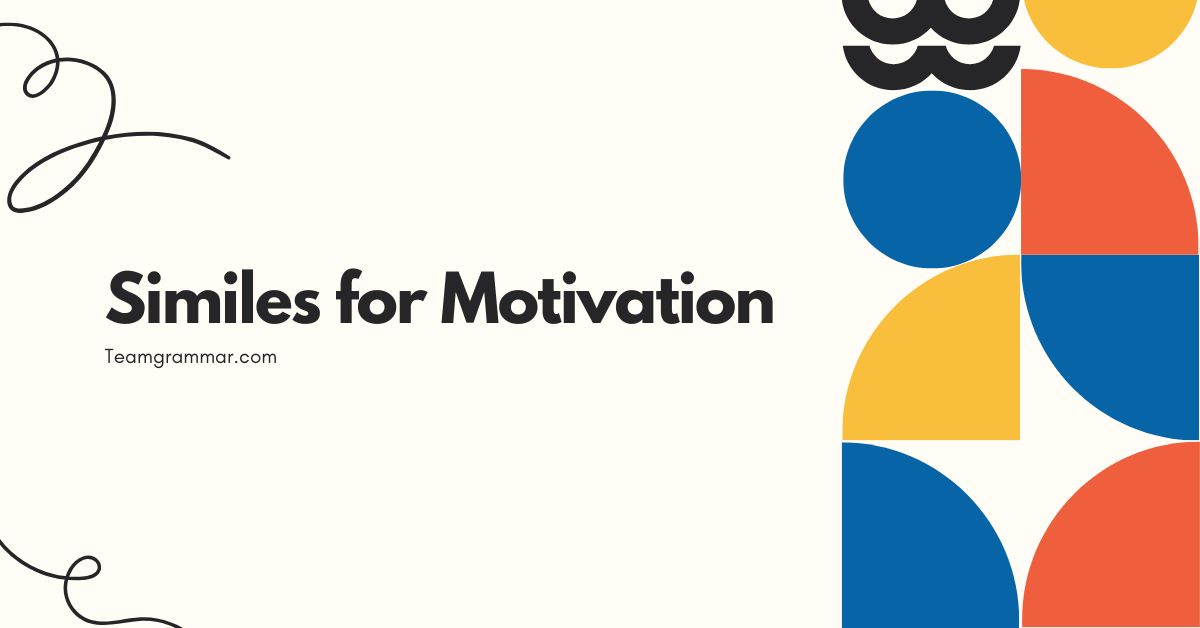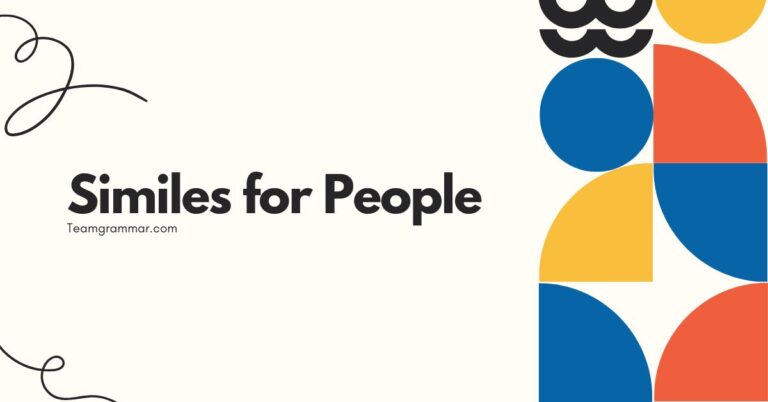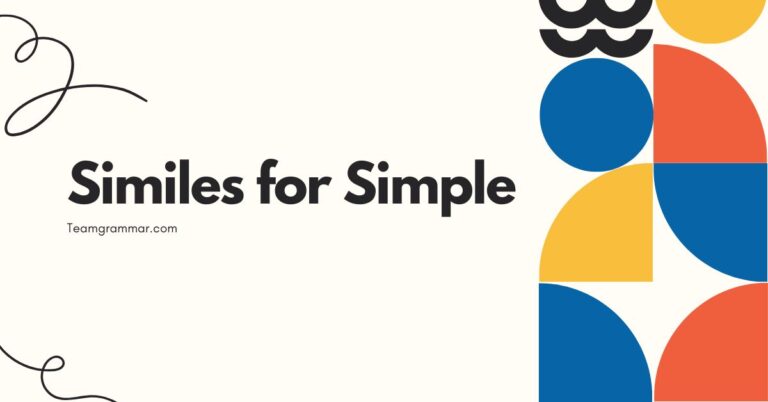39 Similes for Motivation: Boost Your Drive with Figurative Language
Understanding and using similes can significantly enhance your ability to inspire and motivate yourself and others. This article delves into the world of similes, exploring their structure, types, and how they can be effectively employed to create compelling motivational messages.
By mastering the art of crafting impactful similes, you can unlock new levels of persuasive communication and personal drive. This guide is perfect for students, educators, leaders, and anyone looking to add a creative and powerful edge to their language.
Similes, a cornerstone of figurative language, offer a unique way to connect with audiences on an emotional and intellectual level. They paint vivid pictures, making abstract concepts more relatable and memorable.
Whether you are writing a motivational speech, crafting a personal mantra, or simply seeking to infuse your daily communication with more energy, the knowledge of similes and their motivational application will prove invaluable. This comprehensive guide provides a solid foundation for mastering this skill.
Table of Contents
- Definition of Simile
- Structural Breakdown
- Types or Categories of Similes
- Examples of Similes for Motivation
- Usage Rules
- Common Mistakes
- Practice Exercises
- Advanced Topics
- FAQ
- Conclusion
Definition of Simile
A simile is a figure of speech that directly compares two different things, explicitly using the words “like” or “as.” The purpose of a simile is to create a vivid image or convey a particular feeling by associating the qualities of one thing with another. It is a tool used to make descriptions more interesting and relatable, enabling the audience to grasp a concept more easily and remember it more effectively.
Similes are a type of metaphor, but unlike metaphors, they make the comparison explicit. While a metaphor might state that “life is a journey,” a simile would say “life is like a journey.” This direct comparison is what distinguishes similes from other forms of figurative language.
In the context of motivation, similes can be particularly powerful. They can help to frame challenges in a new light, inspire confidence, and create a sense of possibility.
By comparing a goal to something achievable or a struggle to something surmountable, similes can shift perspectives and foster a more positive and determined mindset.
Classification of Similes
Similes can be classified based on the type of comparison they make. They can compare physical attributes, emotional states, abstract concepts, or even actions.
The key is that the comparison must be meaningful and create a clear connection between the two things being compared.
For example, a simile that compares physical attributes might say, “He is as strong as an ox.” A simile that compares emotional states might say, “She felt like a bird set free.” These classifications are not rigid, but they can help in understanding the different ways similes can be used to create different effects.
Function of Similes
The primary function of a simile is to enhance understanding and create imagery. It allows the speaker or writer to paint a picture in the mind of the audience, making the message more engaging and memorable.
In motivational contexts, similes function to inspire, encourage, and reframe perspectives.
For instance, instead of simply saying “You need to be persistent,” a motivational speaker might say, “Be persistent like water wearing down a stone.” This simile not only emphasizes the importance of persistence but also creates a powerful image of steady, unwavering effort leading to eventual success.
Contexts for Using Similes
Similes are appropriate in a wide range of contexts, from formal speeches and written articles to casual conversations and personal affirmations. They can be used in any situation where the goal is to make a message more vivid, relatable, and memorable.
In business settings, similes can be used to motivate teams and inspire innovation. In educational settings, they can help students grasp complex concepts.
In personal development, they can be used to build self-confidence and overcome challenges. The key is to choose similes that are relevant to the audience and appropriate for the context.
Structural Breakdown
The structure of a simile is relatively simple, consisting of three main components: the subject, the comparison word (“like” or “as”), and the object of comparison. Understanding this structure is crucial for crafting effective and impactful similes.
The subject is the thing being described or compared. The comparison word establishes the relationship between the subject and the object of comparison.
The object of comparison is the thing that the subject is being compared to. Together, these three components create a simile that conveys a specific meaning or evokes a particular image.
For example, in the simile “He is as brave as a lion,” “he” is the subject, “as” is the comparison word, and “a lion” is the object of comparison. This structure allows for a clear and direct comparison, making the simile easy to understand and remember.
Subject
The subject of a simile is the entity or concept that is being described or compared. It can be a person, a place, a thing, or an idea.
The subject is the focal point of the simile, and the comparison is made in relation to it.
Choosing the right subject is essential for creating an effective simile. The subject should be something that the audience can easily relate to and understand.
It should also be something that is relevant to the overall message or context.
Comparison Word
The comparison word is the word that connects the subject and the object of comparison. The two most common comparison words are “like” and “as.” These words signal that a comparison is being made and establish the relationship between the two things being compared.
While “like” and “as” are the most common comparison words, other words can also be used in certain contexts. For example, words such as “resembles” or “is similar to” can be used to create a simile, although these are less common and may sound more formal.
Object of Comparison
The object of comparison is the entity or concept that the subject is being compared to. It provides the basis for the comparison and helps to create a vivid image or convey a particular feeling.
The object of comparison should be something that is well-known and easily understood by the audience.
Choosing the right object of comparison is crucial for creating an effective simile. The object should have qualities or characteristics that are similar to those of the subject, and the comparison should be meaningful and relevant to the overall message.
Types or Categories of Similes
Similes can be categorized based on the type of comparison they make. Understanding these categories can help you to choose the most appropriate simile for a particular context and to create more impactful and effective motivational messages.
Some common categories of similes include similes that compare physical attributes, emotional states, abstract concepts, and actions. Each of these categories serves a different purpose and can be used to create different effects.
Similes Comparing Physical Attributes
These similes compare the physical characteristics of two things. They can be used to describe someone’s appearance, strength, speed, or other physical qualities.
In motivational contexts, these similes can be used to inspire confidence and encourage physical activity.
For example, “He is as strong as an ox” is a simile that compares someone’s strength to that of an ox. This simile can be used to inspire someone to push themselves physically and to believe in their own strength.
Similes Comparing Emotional States
These similes compare the emotional state of two things. They can be used to describe someone’s feelings, mood, or attitude.
In motivational contexts, these similes can be used to evoke empathy, encourage optimism, and help people to understand and manage their emotions.
For example, “She felt like a bird set free” is a simile that compares someone’s feeling of freedom to that of a bird being released from a cage. This simile can be used to inspire a sense of liberation and to encourage people to pursue their dreams.
Similes Comparing Abstract Concepts
These similes compare abstract concepts, such as time, knowledge, or success. They can be used to make abstract ideas more concrete and relatable.
In motivational contexts, these similes can be used to inspire creativity, encourage learning, and help people to understand and achieve their goals.
For example, “Knowledge is like a garden: if you do not cultivate it, you cannot harvest it” is a simile that compares knowledge to a garden. This simile emphasizes the importance of learning and continuous effort in acquiring knowledge.
Similes Comparing Actions
These similes compare the actions of two things. They can be used to describe how someone behaves, works, or performs.
In motivational contexts, these similes can be used to inspire action, encourage perseverance, and help people to develop positive habits.
For example, “He worked like a beaver building a dam” is a simile that compares someone’s work ethic to that of a beaver. This simile emphasizes the importance of hard work and dedication in achieving success.
Examples of Similes for Motivation
Here are several examples of similes that can be used for motivation, categorized by the aspect of motivation they aim to address. These examples are designed to inspire, encourage, and reframe perspectives.
The following tables provide a wide range of similes, each with a specific focus and intended effect. These examples can be used as inspiration for creating your own similes or as direct quotes in motivational speeches, articles, or personal affirmations.
Similes for Achieving Goals
These similes emphasize the importance of perseverance, dedication, and strategic planning in achieving goals. They are designed to inspire confidence and encourage a proactive approach to pursuing dreams.
Below is a table of similes designed to encourage goal achievement. Notice how each simile uses vivid imagery to emphasize the importance of effort, strategy, and resilience in the pursuit of goals.
| Simile | Motivational Focus |
|---|---|
| Achieving your goals is like climbing a mountain; take one step at a time. | Incremental progress |
| Your potential is like a seed; it needs nurturing to grow. | Growth and development |
| Success is like baking a cake; you need the right ingredients and a good recipe. | Planning and preparation |
| Persistence is like a river; it carves its path through even the toughest obstacles. | Overcoming obstacles |
| Your dreams are like stars; keep reaching for them, no matter how far away they seem. | Aspiration and ambition |
| Learning is like building a house; start with a strong foundation. | Building a strong foundation |
| Challenges are like puzzles; each piece helps you see the bigger picture. | Problem-solving |
| Opportunities are like sunrises; if you wait too long, you miss them. | Seizing opportunities |
| Your vision is like a lighthouse; it guides you through the storm. | Guidance and direction |
| Progress is like a snowball; it gets bigger and faster as it rolls. | Momentum and growth |
| Your mind is like a parachute; it only works if it’s open. | Open-mindedness |
| Knowledge is like a map; it helps you navigate unknown territories. | Exploration and discovery |
| Ideas are like sparks; they can ignite a revolution. | Innovation and change |
| Your voice is like a song; let it be heard. | Self-expression |
| Your spirit is like a flame; protect it from being extinguished. | Resilience and passion |
| Your journey is like a book; each chapter tells a different story. | Life experiences |
| Your potential is like a diamond; it needs polishing to shine. | Refinement and improvement |
| Your strength is like a shield; it protects you from harm. | Protection and resilience |
| Your determination is like a compass; it guides you to your destination. | Direction and focus |
| Your efforts are like seeds; they will eventually bear fruit. | Patience and perseverance |
| Your success is like a garden; it requires constant care and attention. | Continuous effort |
| Your courage is like a muscle; the more you use it, the stronger it gets. | Building courage |
| Your resilience is like a rubber band; it stretches and bounces back. | Bouncing back from adversity |
| Your creativity is like a river; let it flow freely. | Unleashing creativity |
Similes for Overcoming Challenges
These similes focus on resilience, adaptability, and the ability to learn from failures. They are designed to help people view challenges as opportunities for growth and to encourage a positive and proactive approach to problem-solving.
The table below illustrates similes that address the theme of overcoming challenges. These comparisons aim to foster resilience, adaptability, and a positive outlook in the face of adversity.
| Simile | Motivational Focus |
|---|---|
| Challenges are like storms; they may be fierce, but they eventually pass. | Temporary nature of challenges |
| Failure is like fertilizer; it helps you grow stronger. | Learning from mistakes |
| Setbacks are like detours; they may change your path, but they don’t have to stop you. | Adaptability and resilience |
| Adversity is like a whetstone; it sharpens your skills. | Skill enhancement |
| Problems are like knots; they may be difficult to untangle, but they can be solved. | Problem-solving |
| Fear is like a shadow; it disappears when you face it. | Confronting fears |
| Doubt is like a weed; it needs to be pulled out before it chokes your potential. | Eliminating doubt |
| Criticism is like rain; it can nourish your growth if you let it. | Constructive feedback |
| Obstacles are like hurdles; they are meant to be jumped over. | Overcoming obstacles |
| Difficulties are like lessons; they teach you valuable things. | Learning from difficulties |
| Pressure is like coal; it can turn you into a diamond. | Transformation under pressure |
| Pain is like a messenger; it tells you something is wrong. | Identifying problems |
| Loss is like winter; it makes you appreciate the spring. | Appreciating the good times |
| Regret is like a ghost; it haunts you until you learn from it. | Learning from the past |
| Change is like the tide; it is inevitable. | Accepting change |
| Grief is like a wound; it heals with time. | Healing process |
| Loneliness is like a desert; it makes you appreciate connection. | Value of connection |
| Disappointment is like a lesson; it teaches you what to avoid. | Learning from disappointment |
| Mistakes are like stepping stones; they lead you to success. | Path to success |
| Challenges are like puzzles; solving them makes you smarter. | Intellectual growth |
| Resilience is like a tree; it bends but doesn’t break in the storm. | Staying strong in tough times |
| Patience is like a seed; it takes time to grow. | The virtue of patience |
| Hope is like a light; it guides you in the darkness. | Finding hope in despair |
Similes for Building Confidence
These similes aim to boost self-esteem, encourage self-belief, and inspire a sense of empowerment. They are designed to help people recognize their strengths, embrace their potential, and believe in their ability to achieve their goals.
The table below presents similes focused on building confidence. These comparisons are crafted to instill self-belief, encourage the recognition of personal strengths, and promote a sense of empowerment.
| Simile | Motivational Focus |
|---|---|
| Your potential is like a hidden treasure; it’s waiting to be discovered. | Unlocking potential |
| Your voice is like a melody; it deserves to be heard. | Expressing yourself |
| Your worth is like a precious gem; it’s invaluable. | Self-worth |
| Your mind is like a garden; plant positive thoughts and watch them grow. | Positive thinking |
| Your heart is like a compass; it will guide you to your true north. | Following your heart |
| Your spirit is like a flame; let it burn brightly. | Passion and enthusiasm |
| Your strength is like a fortress; it protects you from negativity. | Inner strength |
| Your courage is like a shield; it defends you from fear. | Bravery and resilience |
| Your smile is like sunshine; it brightens the world. | Positive impact |
| Your kindness is like a ripple; it spreads far and wide. | Kindness and compassion |
| Your creativity is like a river; let it flow freely. | Unleashing creativity |
| Your imagination is like a playground; explore it without limits. | Imagination and innovation |
| Your dreams are like seeds; plant them with hope and watch them grow. | Hope and aspiration |
| Your abilities are like tools; use them to build your future. | Utilizing skills |
| Your potential is like a blank canvas; paint it with your dreams. | Creating your future |
| Your knowledge is like a light; it illuminates your path. | Guidance and wisdom |
| Your wisdom is like a tree; it grows stronger with age. | Growth with experience |
| Your intuition is like a whisper; listen to it carefully. | Trusting intuition |
| Your passion is like a fire; let it fuel your dreams. | Fueling ambition |
| Your determination is like a rock; it cannot be broken. | Unwavering determination |
| Your self-belief is like a rudder; it steers you in the right direction. | Steering towards success |
| Your individuality is like a fingerprint; it sets you apart. | Celebrating uniqueness |
| Your enthusiasm is like a magnet; it attracts positivity. | Attracting positive energy |
Usage Rules
Using similes effectively requires understanding the basic rules of grammar and syntax, as well as an awareness of the nuances of language. Here are some key rules to keep in mind when crafting similes:
First, ensure that the comparison is logical and meaningful. The two things being compared should have some common characteristic or quality that makes the comparison relevant.
Second, use clear and concise language to avoid confusion. The simile should be easy to understand and should not require the audience to make too many mental leaps.
Finally, be creative and original. While it’s fine to use common similes, try to come up with your own unique comparisons to make your message more memorable and impactful.
Ensuring Logical Comparisons
The most important rule for using similes effectively is to ensure that the comparison is logical and meaningful. The two things being compared should have some common characteristic or quality that makes the comparison relevant.
If the comparison is illogical or nonsensical, the simile will be confusing and ineffective.
For example, comparing “success” to “a sunny day” is logical because both represent something positive and desirable. However, comparing “success” to “a rusty nail” would be illogical because there is no clear connection between the two.
Using Clear and Concise Language
Another important rule is to use clear and concise language. The simile should be easy to understand and should not require the audience to make too many mental leaps.
Avoid using overly complex or obscure language that could confuse the audience.
For example, instead of saying “His determination was as inexorable as the relentless march of time,” you could say “His determination was as strong as iron.” The second simile is much easier to understand and more impactful.
Being Creative and Original
While it’s fine to use common similes, try to come up with your own unique comparisons to make your message more memorable and impactful. Original similes are more likely to capture the audience’s attention and to create a lasting impression.
For example, instead of saying “He is as brave as a lion,” you could say “He is as brave as a firefighter running into a burning building.” The second simile is more specific and creates a more vivid image.
Common Mistakes
Even experienced writers and speakers can make mistakes when using similes. Here are some common mistakes to avoid:
One common mistake is using clichés or overused similes. These similes have lost their impact and can make your writing or speaking sound unoriginal.
Another mistake is using illogical or nonsensical comparisons. The two things being compared should have some common characteristic or quality that makes the comparison relevant.
Finally, using similes that are too complex or obscure can confuse the audience and weaken your message.
The following table illustrates some common mistakes when using similes, along with corrected examples to show the proper usage and impact of well-crafted similes.
| Incorrect Simile | Corrected Simile | Explanation |
|---|---|---|
| He was as busy as a bee. | He was as busy as a conductor leading an orchestra. | The corrected simile is more specific and creates a more vivid image. |
| She was as happy as a clam. | She was as happy as a child on Christmas morning. | The corrected simile is more relatable and evokes a stronger emotional response. |
| The problem was as big as a house. | The problem was as big as a mountain looming in the distance. | The corrected simile creates a more dramatic and impactful image. |
| He ran like the wind. | He ran like a cheetah chasing its prey. | The corrected simile is more specific and creates a more dynamic image. |
| The speech was as dry as dust. | The speech was as dry as parchment left in the sun. | The corrected simile is more descriptive and creates a more vivid impression. |
| The solution was as clear as mud. | The solution was as clear as a freshly cleaned window. | The corrected simile provides a more logical and understandable comparison. |
| He was as strong as an ox. | He was as strong as a weightlifter hoisting a heavy barbell. | The corrected simile is more modern and creates a more relatable image. |
| She was as quiet as a mouse. | She was as quiet as a librarian in a silent reading room. | The corrected simile is more specific and creates a more contextual image. |
| The task was as easy as pie. | The task was as easy as following a simple recipe. | The corrected simile is more relatable and provides a clearer understanding. |
| He slept like a log. | He slept like a bear hibernating through the winter. | The corrected simile is more vivid and creates a more impactful image. |
Practice Exercises
Test your understanding of similes with these practice exercises. For each exercise, create a simile that fits the given context or completes the given sentence.
The answers are provided below, but try to complete the exercises on your own first.
These exercises are designed to help you practice crafting effective and impactful similes. They cover a range of topics and contexts, allowing you to develop your skills in using similes for different purposes.
- Complete the simile: Her determination was as strong as _____.
- Create a simile to describe the feeling of accomplishment.
- Complete the simile: Overcoming obstacles is like _____.
- Create a simile to describe the importance of teamwork.
- Complete the simile: His motivation was as high as _____.
- Create a simile to describe the feeling of inspiration.
- Complete the simile: Learning new skills is like _____.
- Create a simile to describe the importance of perseverance.
- Complete the simile: Their commitment was as unwavering as _____.
- Create a simile to describe the feeling of empowerment.
Answers:
- Her determination was as strong as steel.
- The feeling of accomplishment is like reaching the summit of a mountain after a long climb.
- Overcoming obstacles is like navigating a maze.
- The importance of teamwork is like the gears in a clock working together.
- His motivation was as high as the sky.
- The feeling of inspiration is like a spark igniting a fire.
- Learning new skills is like adding tools to your toolbox.
- The importance of perseverance is like water wearing down a stone.
- Their commitment was as unwavering as the North Star.
- The feeling of empowerment is like having wings and learning to fly.
Advanced Topics
For advanced learners, there are several more complex aspects of similes to explore. These include the use of extended similes, the combination of similes with other figures of speech, and the cultural variations in the use of similes.
Extended similes involve developing a comparison over several sentences or paragraphs, creating a more detailed and nuanced image. Combining similes with other figures of speech, such as metaphors and personification, can create even more powerful and evocative language.
Understanding cultural variations in the use of similes can help you to communicate more effectively with diverse audiences.
Extended Similes
An extended simile is a simile that is developed over several sentences or paragraphs, creating a more detailed and nuanced comparison. This allows the writer or speaker to explore the similarities between the two things being compared in greater depth.
For example, instead of simply saying “Life is like a journey,” an extended simile might say “Life is like a journey, full of unexpected twists and turns, challenging obstacles, and breathtaking vistas. Along the way, we encounter fellow travelers who offer guidance and support, and we learn valuable lessons that shape who we become.
The destination is not as important as the experiences we have along the way.”
Combining Similes with Other Figures of Speech
Similes can be combined with other figures of speech, such as metaphors and personification, to create even more powerful and evocative language. This allows the writer or speaker to layer different types of comparisons and imagery, creating a richer and more complex effect.
For example, a simile might be combined with personification to say “The wind howled like a hungry wolf, tearing at the trees and clawing at the windows.” This combines the simile “howled like a hungry wolf” with the personification of the wind as having human-like qualities.
Cultural Variations in the Use of Similes
The use of similes can vary significantly across different cultures. What is considered a common or appropriate simile in one culture may be unfamiliar or even offensive in another culture.
Understanding these cultural variations is essential for effective communication with diverse audiences.
For example, a simile that references a specific animal or plant may be meaningful in one culture but meaningless in another. Similarly, a simile that relies on a particular cultural reference or historical event may not be understood by people from other cultures.
FAQ
Here are some frequently asked questions about similes:
- What is the difference between a simile and a metaphor?
A simile explicitly compares two things using “like” or “as,” while a metaphor implies a comparison without using these words. For example, “He is as brave as a lion” is a simile, while “He is a lion” is a metaphor. - Can a simile be a cliché?
Yes, if it’s overused. Clichés are similes or phrases that have lost their impact due to overuse. It’s better to use fresh, original comparisons. - How do I make my similes more creative?
Think outside the box. Consider unexpected comparisons that still make sense. Use vivid imagery and sensory details to make your similes more memorable. - Is it okay to use similes in formal writing?
Yes, but use them sparingly and appropriately. Similes can add color and clarity to formal writing, but too many can make it seem informal or unprofessional. - What are some common mistakes to avoid when using similes?
Avoid clichés, illogical comparisons, and overly complex language. Make sure your similes are clear, concise, and meaningful. - How can I use similes to be more persuasive?
Choose similes that resonate with your audience and evoke strong emotions. Use them to make abstract concepts more relatable and memorable. - Can I use similes in everyday conversation?
Absolutely! Similes can make your everyday conversations more engaging and interesting. They can help you express yourself more vividly and connect with others on a deeper level. - How do I know if a simile is effective?
An effective simile creates a clear and vivid image in the reader’s mind, enhances understanding, and adds emotional impact to your message. If your simile achieves these goals, it is likely to be effective. - Are similes only used in writing?
No, similes are used in both writing and speaking. They are a versatile tool for enhancing communication in any context. - How do I learn to create better similes?
Practice, practice, practice! Read widely, pay attention to the similes used by other writers and speakers, and experiment with creating your own. The more you practice, the better you will become at crafting effective and impactful similes.
Conclusion
Mastering the art of using similes can significantly enhance your motivational communication. By understanding their structure, types, and usage rules, you can craft powerful messages that inspire, encourage, and reframe perspectives.
Remember to focus on creating logical and meaningful comparisons, using clear and concise language, and being creative and original in your approach.
Similes are a valuable tool for anyone looking to add a creative and impactful edge to their language. Whether you are writing a motivational speech, crafting a personal mantra, or simply seeking to infuse your daily communication with more energy, the knowledge of similes and their motivational application will prove invaluable.
Continue to practice and experiment with different types of similes to develop your skills and unlock your full potential as a communicator.







